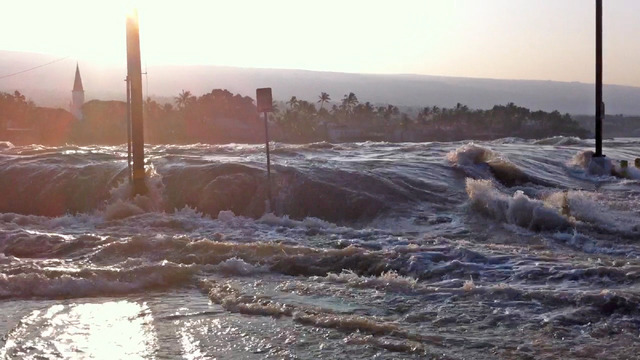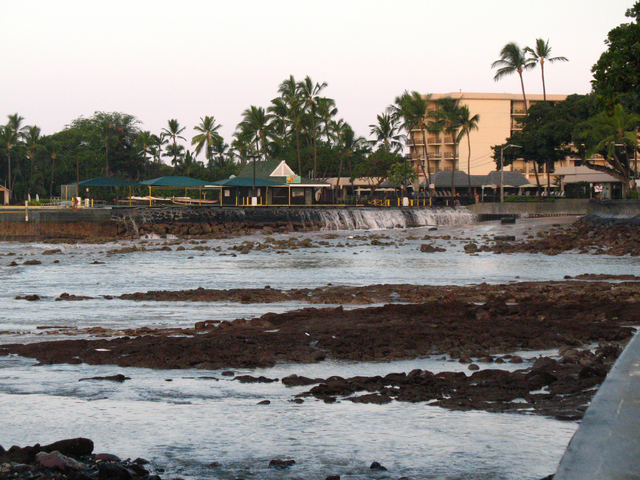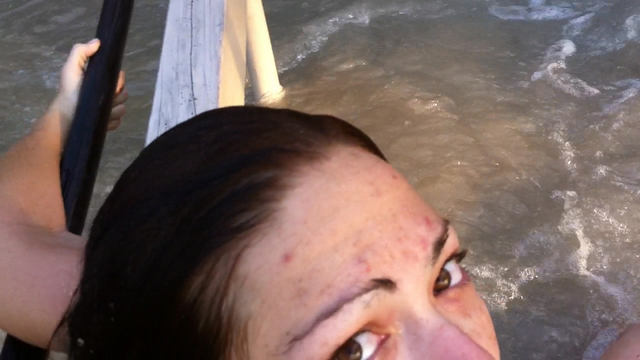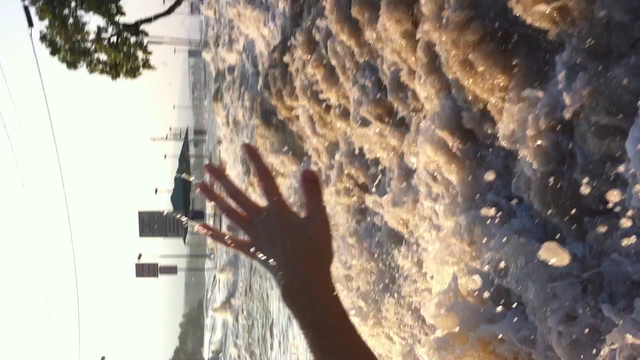Five years later: Reporter reflects on covering tsunami that wrecked West Hawaii








Editor’s note: West Hawaii Today Associate Editor Chelsea Jensen reflects on the March 11, 2011, tsunami that devastated Japan and impacted Kailua-Kona. Born and raised in Kailua-Kona, Jensen, a reporter at the time, risked it all to cover the story and record history earning her Hawaii Pa’i and Society of Professional Journalists awards for photos and writing.
It starts with just another text.
Beep, beep, beep chirps my new iPhone shortly before 8 p.m. March 10, 2011.
It’s a noise I’m used to hearing, just another text message — who wants what now, I wonder. But no, it’s not just another text message and someone needing something. It’s a message that looking back upon now five years later changed not only my life, but the lives of many in the community where I was born and raised.
The text on my screen: A magnitude-7.9 earthquake near the east coast of Honshu, Japan, has struck and a tsunami watch has been issued for Hawaii.
My stomach turns. A pit forms. I’ve got that feeling — that feeling when you know it’s not going to be good, but this time it is serious.
At age 25, I’d been on this Earth for just over a quarter-century, but had never experienced a tsunami or hurricane on the Big Island, or any real major disaster for that matter.
I was lucky, though I do remember a couple instances where watches were issued, like when Hurricane Iniki passed south of the island in 1992, and a couple times the emergency warning sirens blared, including once where me, my sister and parents met up with my grandparents on Kamehameha III Road to wait out tsunami waves that never came. But nothing that made me feel like this.
Looking for confirmation that it wasn’t true, that a tsunami was not coming, that everything was fine, I flipped on the TV. The cameras are fixed on Japan’s shoreline, capturing the massive waves racing toward shore. The virulent water crashing over seawalls constructed to hold back those very waves, racing around buildings, pushing cars and people as if they were just leaves in the wind. The screams from the Japanese watching from floors up as the world rushed by beneath them, their homes, their livelihoods, their families and friends washed away in a moment of sheer terror, sounds I will never forget and images burned in my mind forever.

An hour later, another text informs me that the earthquake was far stronger, a magnitude-8.8. Finally, at 9:31 p.m., it’s official: A tsunami warning has been issued for Hawaii. Days after the temblor, the U.S. Geological Survey would up its strength again, to a magnitude-9.0.
Reality sets in
Could this be it? Could my little Kona town be washed of the face of the Earth? Will we see the destruction, devastation and death like is being played over and over on TV? Knowing that it could all be gone in a matter of hours, Scott, my other half, and I head down to Kailua Pier, where we sit and watch the lights twinkle from the shoreline to the top of Hualalai. I take a video, “just in case.”
With little more to do than stroll the Kailua Village area, we head home, though we are both unable to sleep. About midnight I crash, knowing I had to get some rest because Friday, March 11, 2011, was going to turn out to be a very long day. The first waves were scheduled to reach the island chain sometime after 3 a.m.
Whoosh, the first waves arrive in Kona
I’m not quite sure when the first waves hit Kailua Village, but it was still pitch dark out when the sound of the surf stopped crashing (apparently while the water was pulling out) and it became eerily quiet. Scott was outside on the lanai, “it was about 5:15 a.m.,” he says.
A short time later, seawater bursts through the parking deck of Waterfront Row and onto Alii Drive, over a stonewall and into the parking lot of St. Michael the Archangle Church. Standing on our lanai, up three stories behind the church, we wondered if it would come farther. Luckily, it did not.
Adrenaline rushing and chomping at the bit to get reporting, I had to hold off until at least the crack of dawn. “What could I get right now,” I thought.
First light
It’s 6 a.m. March 11, 2011, when we venture out, me in a dress and slippers with just a camera, cell phone and notebook in hand. I am not sure of what I will find, I just hope no one is hurt and the damage isn’t too bad. We make the trek first heading down through the Kona Islander Inn & Hotel to Alii Drive.
Washed up into the hotel area are fist-sized rocks and quite a bit of sand, but nothing major. Stepping out onto Alii Drive, it is much the same, albeit a few of the rocks tossed up onto the roadway were bigger than my head. Two rock walls, one along Alii Drive south of Bubba Gump Shrimp Co. and the other across the road at Kealaokamalamalama Church are toppled.

At Bubba Gump Shrimp Co. chairs and tables are strewn about, and doors and glass knocked out. A vanity license plate inscribed with “Run, Forrest Run” and “Stop, Forrest Stop” is wrapped around a tree and a table lay on its side in the middle of Alii Drive. The parking garage at Waterfront Row, with vehicles still inside, is filled with a good 5 feet of water.
It’s much the same at Hale Halawai, except for one thing: There’s a pillow stuffed between the metal bars about 4 feet above the ground. “Really? Did that happen? Or, was the tsunami tired?” I wondered. Nah, it must have been somebody wanting to ensure they had a dry pillow after all of this.

Heading north along Alii Drive, the damage seems to increase the closer we get to Kailua Pier. The Kona Inn Restaurant was in shambles, chairs and tables thrown about like they were nothing. Southern swamp lily, ripped from the ground, strewn across the lawn.
I grab a spotted boxfish. “How sad, he’s going to die,” I think before tossing him back into the water. Looking back now, that was a smart move — not really, but at least I tried, that’s what I like to think anyway.

Witnessing the power of the ocean
It’s just then that another tsunami washes in, spraying water up and over what is left of the seawall behind the Kona Inn Shopping Village and a Hawaii County helicopter flies over, signaling “not so smart people” like myself to get away from the shoreline. Pushed far in on the lawn are large chunks of the concrete seawall. Chunks of wall and building at the shopping area are missing and water is spraying from pipes below the buildings.

We venture north, police beginning to clear the area. At Hulihee Palace, we are stopped and diverted onto Alii Drive. As I walk by the Kiope Pond, I see damage: A portion of the small saltwater pond’s wall has been toppled. History destroyed, I remember thinking, also dreading to hear about damage to the palace itself. (In a later tour, I learn the tsunami inundated the facility, filling its basement and destroying some artifacts, but leaving the building in tact.)

Out on Alii Drive, it’s not so bad in this area. Looking left is a guy riding a bicycle too small for him, and a dumpster washed quite a ways from its home. Looking right, I see a jewelry case (empty), hangers and other stuff washed out from businesses just down the way.

It’s much of the same I hear from various business owners and gawkers until we near the sitting wall across the road from Scandinavian Shave Ice. At this time, I notice Kailua Bay emptying. Something I’ve never seen before. Bare rock. Fish jumping. And the sound of water pushed far inland by the last wave, rushing off the edge of the pier like a waterfall back into the ocean.
I hated that sound then, and, I still can’t stand it today, five years later.

Fish out of water
At what was then Tante’s Restaurant, right next to the Fish Hopper, Scott picks up a pretty good size fish flopping in the disappearing water amid some large decorations of bamboo and palm frond that had once been affixed to a building. The buggah was blue and had a lot of meat on it (what it was, I don’t know). However, as quickly as he picked it up, someone ran out from the restaurant eager to grab up an easy catch.
It’s then that we see Alii Drive in shambles, whole sections of the roadway seemingly pushed up from beneath (this would turn out to be the case). Signs bent. Tables on their side, sitting where vehicles should be. Hangers strewn about. Lots of things where they should not be. Including a guy, picking through all the rubble, I can only assume looking for some treasure. (Luckily, from those I talked to theft and looting wasn’t a problem that day).

A police officers yells at him to leave. The guy is oblivious.
Frustration setting in, the officers proceeds to tell everyone to get out and off Alii Drive as Kailua Bay fills. So hard-headed me, I push forward, north along Alii Drive to the pier. I got to get it ALL because, well, that’s just how I roll. Go big or go home.
It’s at this time, I turn around and snap a photo of the stop sign at Kaahumanu Place and Alii Drive. It’s the last photo I would ever take with that camera, and the way it picked up the sun shining after just cresting Alii Drive is ominous in retrospect.

‘Don’t you ever do that again’
It’s 6:56 a.m., March 11, 2011, and water is rushing into Kailua Bay, swirling, churning and gurgling. A pinkish-purple sky silhouettes Hualalai and much of Kailua Village as the sun rises, illuminating the coastline and the damage already done. I capture this all, watching it unfold through the screen of my iPhone.

As the water rises, and rises, and rises. I stand there next to the public storage racks. In a trance, taping. As it comes over the stairs from Kaiakeakua Beach, I yell, “Scott, watch yourself.” He’s somewhere over by the bathrooms.
Wait for it. Wait for it.
As the water overflows the seawall, I realize, I am a moron. I let out the most pathetic sissy scream, turn around and start booking foot, slippers slapping the wet ground and the white water catching up to me. I see some employees, albeit a little smarter than myself, taking off into King Kamehameha’s Kona Beach Hotel.
Then I see foam, it covers my feet, I keep running and then I am no longer running. My feet are swept from beneath me. I am now at the mercy of the ocean. The ocean I did not respect.
I don’t remember thinking much, other than keeping my new iPhone above water. Right, like that mattered — I wound’t be calling anyone if I were dead.

Arms and legs scrambling in the smelly, dirty water, I feel the back of my knees being ripped by lava rock. It’s the wall, right in front of Menehune Coffee. I put my arms out, I don’t know why, and I hook myself on the railing there. (This railing still stands, and I have kissed it many times for saving my life.) I hold on, watching in terror as the water just keeps on coming, rushing in to the hotel, reaching to within a half-foot of the ABC Store sign affixed to the hotel’s exterior.
I am lucky. I catch my breath, muttering a couple not-so-nice words. Shaking. Soaked in that dirty water. I’ve lost my slippahs and my camera is soaked. I quickly pull out its memory card, blowing on it to dry it — please, please I remember thinking, hoping all those photos (one that I would win awards for) were not gone.
OK. Now I’m over it. I’ve had enough. Not. There’s a hotel with glass windows washed out, doors off their hinges, and stuff strewn everywhere — I’ve got to check it out.
At Beaches Resort Wear, gorgeous nightwear and fashions are soaked in the muck, torn from their hangers and racks. It’s a mess. I take a couple of steps and peer inside the hotel (which had just been remodeled) and it is no better and glass is everywhere so I decide not to venture forth.
However, for some odd reason, the tsunami’s water came within inches of the Herb Kane collection in the hotel lobby but never touched the priceless works. (Kane had passed away March 8, and I still think he had something to do with it.)
Stepping back outside, another tsunami is rushing in, luckily smaller than the one that showed me who was boss.
I look toward the intersection at Alii Drive and Kaahumanu Place, and Department of Public Works Director Warren Lee is pulling up in a maroon Isuzu, apparently to check out the scene for himself. Next thing I know, he’s out of his car, and racing up the stairs into what is now Paradise Grill and Tap. His car door remains open as the water rushes in and I make my way mauka on Alii Drive.
After the water backs off, Lee re-emerges, puffing away on his tobacco pipe like a steam engine locomotive barreling down the tracks, trying to get even more speed.
OK. I got lucky twice. I stink like the back end of a bay from being washed in the virulent waters. I go home, scrub myself with burning hot water, trying to rid the dirtiness. Good enough. I put some hydrogen peroxide on the backs of my knees, and slap on some Neosporin to prevent staph infection and head into the office.
There, I run into my mentor, my editor Reed Flickinger, and my mother. The photos are epic, the story’s good. Adrenaline is pumping.
But, mom is not happy.
“Don’t you ever do that again,” she says through her grinding teeth. That tone of voice that’s like their saying your full name when you are really in trouble. That tone.
Round Two
There’s a house floating in Kealakekua Bay. Enough said. I am on my way up down south toward Napoopoo Road. Cell phone service sketchy on a good day, I have none as soon as I top the hill near Walua Road. I’m on my own.
Half-way down Napoopoo Road, at the Kona Pacific Farmers Cooperative, I am stopped, by a very friendly civilian emergency response team member who advises me the road is closed, but that doesn’t mean I can’t hike it. So I do. I start the long, boring and hot trek the last mile down to the bay.
As I near, the sound of bulldozers can be heard. At the bottom of Napoopoo, I look left: The road is covered in boulders washed in by the tsunami. A police officer walks over the mess, meeting up with other personnel assessing the situation. At the wharf is a crowd of locals, watching the tsunami — albeit much smaller than earlier — wash in and then out of the bay.
He tells me “it’s complete devastation.”

It’s here that I see my first glimpse of a blue roof floating over by the pali. That roof was once on a home, pulled from its foundation and pushed across the bay.

On the side of Manini Road, several vehicles sit smashed up and in the water. Another home is pushed off its foundation and inland. Luckily, no one is hurt, and that’s all that really matters, right?
With little else to get down there, and it getting later in the day, I decide to hike my way back to my car. No water nothing. Stubborn, I walked quite a ways. And, then, I violated my parent’s rule: Don’t ever hitchhike.
Thumb up; a local pulls up with kids in the back of his pickup. Shoots, I’ll hitch a ride; there’s kids. I’m done, put a fork in it. It’s a quick ride back to my car, and I grab an ice-cold latte at the coffee shop there before heading back to town to put it altogether for the next day’s paper.
History. In the making.
Reflecting five years later
Hindsight 20-20 I look back on that event and realize just how lucky I, Scott and my community are to still be alive and here today. My heart sinks for the loss Japan felt, however, and my prayers go out to comfort those still in pain.
There’s so much to learn from that day and what each person takes away is different. The dress and broken camera serve as reminders.
For me, I learned that my “quaint little drinking village with a fishing problem,” Kailua-Kona, is not invincible, we are not protected from tsunami or hurricane. I also learned a new respect for the ocean and for heeding warnings not to be in areas, though I am reporter.
I also gained a lot of knowledge about the community I was born and raised in and work for everyday: That we are resilient and no matter how long it takes we get back to normal and move forward. And, I’d rather live nowhere else and survive alongside anybody else.
Oh and yea, I learned not to mess with my mom. All this happened on my mom’s birthday, March 11, just to put the cherry on top.
Five years later, I still have to say I’m sorry Mom!
But, I’d do it again!!! Happy Birthday!






